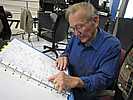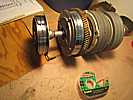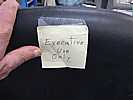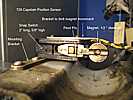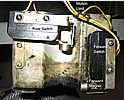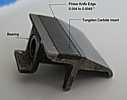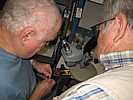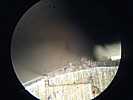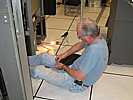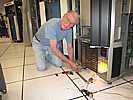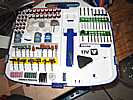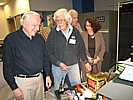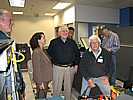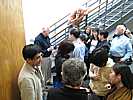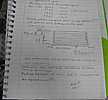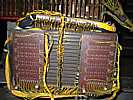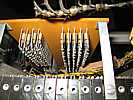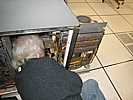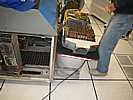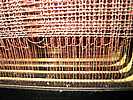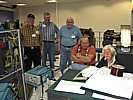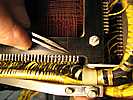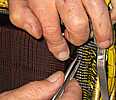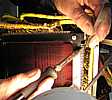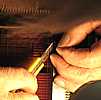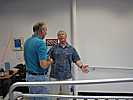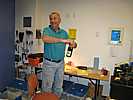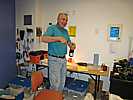Schedule March 2007
return to main 1401 Restoration Page
go to Team Bios
Contents:
Wed March 07 - general
Thu March 08 - Tape Team
Sat March 10 - 2nd Sat - Volunteer Day - BBC visits ;-))
Wed March 14 - general
IBM wanted to verify that the above system worked - so sensed the capstan position as follows:
Thu March 15 - Tape Team
Wed March 21 - general
Thu March 22 - Tape Team
Sat March 24 - 4th Sat
I initially tested several with a meter and got what looked like bad readings on many.
Later I retested them using my curve tracer and they all tested good. The only problem being that the
junctions were slightly resistive instead of being "pure diodes" (which was probably what confused the meter).
The new Ge transistors you have are perfectly fine! No need to go to Si.
Wed March 28 - general
I initially tested several with a meter and got what looked like bad readings on many.
Later I retested them using my curve tracer and they all tested good. The only problem being that the
junctions were slightly resistive instead of being "pure diodes" (which was probably what confused the meter).
The new Ge transistors you have are perfectly fine! No need to go to Si.
Ron Williams, Bill Flora, and Chuck Kantman found a card that was excessively loading a driver, causing a slow rise time which
may have been the cause of some of our unreliability.
OK - I better warn you
Then Bob wondered out loud what to do next. I suggested making plastic covers so that people can see into the
insides of 1401 equipment he has done such a good job with the 077 collator - but Bob figures that the
solvents in the glues are tough on his lungs
Great - any programmer is delighted getting more memory ;-))
Sept 1, 2006 - Bob Feretich and Ron Crane got down and under the low 1406 unit and probed with an ohmmeter and determined
which terminal in which core plane was showing open. By great good luck, it was the bottom plane - most easily damaged,
and most easily accessible.
Added November 1, 2010 - factory repair of core stacks.
Post script:
Frank King said
PostPost script: - is there such??
If they never heard of core array repair in the field they never read
my story
43.5 1401 Print Buffer Surgery.
My failure was in the middle plane and I had to split the array apart, but I cheated.
I turned the power off ;-))
Kristin Abkemeier, who has interviewed Bob Erickson for a story e-mailed
If this was Japan, Bob
would be a living national treasure. (I hope he had a great time on
the Queen Mary 2, which I saw sail into SF the weekend after I last
visited y'all.)
And hey, if you're going to have a party in June, don't forget to invite me!
Thur March 29 - Tape Team
Wed March 07 - general,
Sat March 10 - 2nd Sat., - Volunteer Day - BBC visits ;-))
Wed March 14 - general,
Thu March 15 - Tape Team,
Wed March 21 - general,
Thu March 22 - Tape Team,
Sat March 24 - 4th Sat.
Wed March 28 - general & core plane repair,
Thu March 29 - Tape Team,
Present Ron Williams, Allen Palmer, Tim Coslet. Mike Cheponis was in and out.
Robert Garner was on "athletic leave", skiing with his wife.
- doesn't seem to work when we first get in.
- stayed 'till 5:30. They didn't even go through Visible Storage
Documentary, not an interview type thing. They had a script and things they wanted to photograph
Their narrator was the only person "on camera".
Our crew had to leave the room during "filming"
They photographed the 1402 Card Reader reading and selecting, the mag tape running
They did not seem interested in the 1403 printer :-|
This is to be part of a seven hour presentation -
No new paint, etc. ...
- The working 729 mag tape drive was the hit for the TV folks
- The BBC folks have a three part series under way
- Part 1 is early mechanical technology. - 4 hours
- Part 2 focuses on computing and will include the 1401 segment. - 3 hours
- Part 3 will focus on the future of computing
-- quantum machines, the collapse of Moore's Law, etc. - 3 hours
- The BBC host is Prof. Michio Kaku
- from Santa Clara County (where CHM is located)
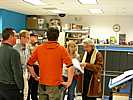
w Ron Williams
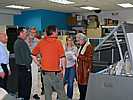
w Bill Worthington
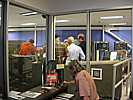
w Tim Coslet
Tim says "I'd already finished tracking down the bad transistors by the time they arrived (8 leaky ones on one ADB card!)
This is the worst ADB I've seen! Maybe next time I'll try replacing them (in small groups needed to get individual
flip-flops working, until I hopefully get the whole card working). Mostly I was curious what was happening.
Noon - brown bag lunch (bring your own) with Len Shustk (Chairman of the Board of CHM) noon to 1:30 - free pop & cookies
Frank related the story of an IBM salesman who had a sorter jam during a demo. The salesman smoothly said
"Look, the machine even found a bad card and destroyed it so it won't bother again." The savvy folks in the
audience were so amused and amazed by the performance that they bought anyway - probably figuring any
organization that was so clever and slick should be able to keep the machinery running. - Maybe our docents
will need to have quick "work arounds"!!
Here is Frank King. Whatcha doin with the 083 sorter, Frank??
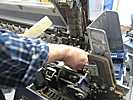
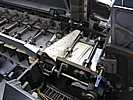
Oh bummer !! Another card jam. Hey Frank, ya just can't blame the cards all the time
- Museum finances, money drives, endowments, financial security
- The hoped for new warehouse in Fremont, CA, and what is planned for it.
- Plans for the Time Line and Museum - and how to comply with the Fire Marshall :-|
- Restoration activities, maintenance of the restored systems,
I felt much more informed about museum activities and plans
Later, Frank King wrote
Robert Garner and Ed Thelen presented/listened to plans for
presenting the 1401 to future visitors to the museum exhibits staff.
And Thursday, Grant Saviers wrote
We have worn feed knifes on both the 1402 reader and the 083 sorter in the 1401 room.
I believe the worn knifes are causing misreading in the 1402 and jamming
as well as misreading in the 083.
I have checked with Grant Saviers and a Tool and Die Shop in Morgan Hill;
both have indicated it would be touchy to restore them to the original new
specifications. This is because of the hardness of the material
and the sharp 90 degree .00425 inch step required.
There are 2 other solutions that I believe are worth pursuing
before we try to have them machined.
1. Have Robert Gardner check with his contact that has a lot of parts for IBM machines.
Two of the part numbers are 223082 (steel) and 603850 (plastic).
I think that punch, reader and sorter are all interchangeable.
2. Ask Dag Spicer to allow us to interchange the knives with punch machines in storage.
i.e. 2540s,1402s or other late model punches, (Late model being after 1960)
The punch knives would have much less wear and even if the machines are used later,
the punch units operates at a much lower speed
and would be much less prone to failure.
Please let me know if you think of other alternatives.
Robert, will you let me know if "your guy" has some of these.
Thanks,
Frank
I will attempt to make a hardened steel gage with .0045 go and .0040 no go steps,
so the knives can be measured. This will prompt me to get my newer grinder on line,
so don't hold your breath :-) . I'll pick through my odds and ends collection
of diamond wheels and see if anything is worth trying on the carbide.
While diamond grinding wheels are required for carbide and will need to be carefully
dressed to get the sharp inside corner on the carbide, a high end grinding shop
should be able to refurbish the feed knives, particularly since the total material
to be removed is likely only .001 or .002. Can the pickers be set to offset the
lower overall knife height when they are reground?
Please confirm or new knives will need to be made.
I'll make some more contacts to try and find a suitable grinding shop,
and a service that can profile measure the worn ones.
I stopped by the 1401 room today and see that you removed the sorter knives.
If you would bring them to my shop next week M/T/W, I'll make some measurements.
Let me know by email what works for you, shop phone 408 929 8413.
Grant
Later, Tim Coslet e-mailed:
About my comments about Ge transistors.
Details later in this massive message.
Later, Tim Coslet e-mailed:
About my comments about Ge transistors.
Chuck Kantmann is in the background

Ron says the bottom trace should be the mirror image of the sharp upper trace -
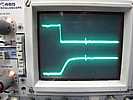
- if you aren't a techie, you might not enjoy the following techie core memory stuff
- how about fixing the broken wire in the 1406 extended memory.
But no one present had ever heard of a field repair of a core plane. (Did Bob say he fixed a 704 core plane
at Los Alamos?? - I will call Bob tomorrow.)
- each half select threaded through every core plane
- to minimize noise from select currents and imperfect
core hysterisis curves
Mid 2006, the 1401 and 1406 (extended memory) was working well enough for Ron to determine that the top 8,000 character
memory stack had a periodic single bit error that was not caused by a bad logic card - likely an open core
stack half select wire - :-(( - There are other problems in that core stack, see here.
Soldering is complete. Ron Williams reported the error caused by this broken wire is now fixed.
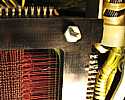
Re-assembling the 1406 extended memory unit.
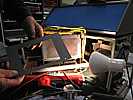
CONGRATULATIONS !! Ron and Allen congratulating Bob. Does Bob look a little tired??
Sports announcers love to talk about stress - Yeah - I bet Bob knows about stress. One slip in the past two hours
and there would have been almost fatal damage to a core memory
1960 price about $55,000 !! (about 4 houses at the time)
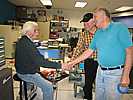
I checked with Ron Williams and Frank King to make sure that I was on the straight and narrow.
Ron Williams said
Yes - the problems caused by that broken wire are fixed - but there are still problems in that upper memory:
It would be good to use a current probe to verify circuits are working as expected.
Same equipment would be useful to check this situation also
He had never heard of field repair of 1401 core planes - send the stack back to the factory.
John Van Gardner, of near Atlanta, Georgia e-mailed
Ed,
The guys did a good job on the 1406 array. I still have my Ungar
Imperial soldering iron with the gold plated iron tip and a roll of
.010" diameter plastic rosin core 60/40 solder used to work on 2361 LCS
memories.
Van Gardner

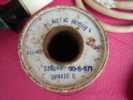
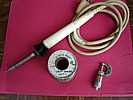

More of John's stories can be found here
here
and computer stories in general
here. :-))
...
I just checked out the project website and saw the photo essay on Bob
Erickson fixing the core plane! Amazing! This totally has to go into
the story. I wish I could have witnessed this. How many core planes
on the planet still get fixed by someone who has firsthand knowledge
from when they were the latest technology?
Go to April 2007
go to Team Bios


